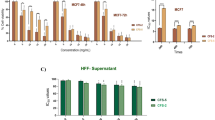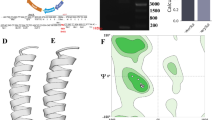Abstract
Macrophage type 2 (M2) is closely associated with tumor progression and metastasis. Thus, in this study, the antitumor effect of Styrax japonica Siebold et al. Zuccarini (SJSZ) glycoprotein on HepG2 cell proliferation through modulating M2 was investigated by measuring [3H]-thymidine incorporation and proliferating cell nuclear antigen (PCNA), nitric oxide (NO), reactive oxygen species (ROS), mitogen-activated protein kinases, signal transducer and activator of transcription (STAT) 6, cytokines [interleukin (IL)-4, IL-10, IL-12, and interferon (IFN)-γ], and CD163-positive cells using biochemical analysis, radioactivity, Western blot, ELISA, quantitative real-time polymerase chain reaction, and flow cytometry in coculture system. RAW 264.7 cells were found to be cytotoxic to HepG2 cells but [3H]-thymidine incorporation and expression of PCNA was suppressed in the presence of the SJSZ glycoprotein (20 μg/ml). The SJSZ glycoprotein normalized production of NO and ROS and expression of inducible nitric oxide synthase, IFN-γ, and IL-12 but suppressed expression of pSTAT6, IL-4, IL-10, and CD163-positive cells. Thus, the results of this study suggest that the SJSZ glycoprotein suppresses proliferation of HepG2 cells by modulating M2.








Similar content being viewed by others
References
Whiteside, T.L. 2006. Immune suppression in cancer: Effects on immune cells, mechanisms and future therapeutic intervention. Seminars in Cancer Biology 16: 3–15.
Ince, N., and J.R. Wands. 1999. The increasing incidence of hepatocellular carcinoma. The New England Journal of Medicine 340: 798–799.
Cabrera, R., M. Ararat, M. Ararat, M. Cao, Y. Xu, C. Wasserfall, C. Wasserfall, M.A. Atkinson, M.A. Atkinson, C. Liu, and D.R. Nelson. 2010. Hepatocellular carcinoma immunopathogenesis: Clinical evidence for global T cell defects and an immunomodulatory role for soluble CD25 (sCD25). Digestive Diseases and Sciences 55: 484–495.
Hoechst, B., L.A. Ormandy, M. Ballmaier, F. Lehner, C. Krüger, C. Krüger, M.P. Manns, T.F. Greten, and F. Korangy. 2008. A new population of myeloid-derived suppressor cells in hepatocellular carcinoma patients induces CD4(+)CD25(+)Foxp3(+) T cells. Gastroenterology 135: 234–243.
Curiel, T.J. 2007. Tregs and rethinking cancer immunotherapy. Journal of Clinical Investigation 117: 1167–1174.
Aderem, A., and D.M. Underhill. 1999. Mechanisms of phagocytosis in macrophages. Annual Review of Immunology 17: 593–623.
Mantovani, A., A. Sica, S. Sozzani, P. Allavena, A. Vecchi, A. Vecchi, and M. Locati. 2004. The chemokine system in diverse forms of macrophage activation and polarization. Trends in Immunology 25: 677–686.
Bingle, L., L. Bingle, N.J. Brown, and C.E. Lewis. 2001. The role of tumour-associated macrophages in tumour progression: Implications for new anticancer therapies. The Journal of Pathology 196: 254–265.
Takai, H., M. Ashihara, T. Ishiguro, H. Terashima, T. Watanabe, A. Kato, and M. Suzuki. 2009. Involvement of glypican-3 in the recruitment of M2-polarized tumor-associated macrophages in hepatocellular carcinoma. Cancer Biology & Therapy 8: 2329–2338.
Martinez, F.O., L. Helming, and S. Gordon. 2009. Alternative activation of macrophages: An immunologic functional perspective. Annual Review of Immunology 27: 451–483.
Bafna, A.R., and S.H. Mishra. 2006. Immunostimulatory effect of methanol extract of Curculigo orchioides on immunosuppressed mice. Journal of Ethnopharmacology 104: 1–4.
Sohn, D., F. Essmann, K. Schulze-Osthoff, and R.U. Jänicke. 2006. p21 blocks irradiation-induced apoptosis downstream of mitochondria by inhibition of cyclin-dependent kinase-mediated caspase-9 activation. Cancer Research 66: 1254–11262.
Leary, A.G., H.Q. Zeng, S.C. Clark, M. Ogawa, and M. Ogawa. 1992. Growth factor requirements for survival in G0 and entry into the cell cycle of primitive human hemopoietic progenitors. Proceedings of the National Academy of Sciences 89: 4013–4017.
Lee, J., and K.T. Lim. 2011. Inhibitory effect of phytoglycoprotein (38 kDa) on expression of matrix metalloproteinase-9 in 12-O-tetradecanoylphorbol-13-acetate-treated HepG2cells. Naunyn-Schmiedeberg's Archives of Pharmacology 384: 185–196.
Mosmann, T. 1983. Rapid colorimetric assay for cellular growth and survival: Application to proliferation and cytotoxicity assays. Journal of Immunological Methods 65: 55–63.
Gabelman, B.M., and J.T. Emerman. 2002. Effects of estrogen, epidermal growth factor, and transforming growth factor-a on the growth of human breast epithelial cells in primary culture. Exp Cell Res 201: 113–118.
Green, L.C., D.A. Wagner, J. Glogowski, J. Glogowski, P.L. Skipper, J.S. Wishnok, and S.R. Tannenbaum. 1982. Analysis of nitrate, nitrite, and [15N]nitrate in biological fluids. Anal Biochem 126: 131–138.
Oh, P.S., and K.T. Lim. 2008. Plant glycoprotein modulates the expression of interleukin-1beta via inhibition of MAP kinase in HMC-1cells. Biosci Biotechnol Biochem 72: 2133–2140.
Lowry, O.H., N.J. Rosebrough, A.L. Farr, and R.J. Randall. 1951. Protein measurement with the Folin phenol reagent. J Biol Chem 193: 265–275.
Livak, K.J., and T.D. Schmittgen. 2001. Analysis of relative gene expression data using real-time quantitative PCR and the 2(-delta delta C(T)). Method Methods 25: 402–408.
Yu, H., D. Pardoll, and R. Jove. 2009. STATs in cancer inflammation and immunity: A leading role for STAT3. Nature Reviews Cancer 9: 798–809.
Naderi, S., J.Y. Wang, J.Y. Wang, T.T. Chen, K.B. Gutzkow, K.B. Gutzkow, and H.K. Blomhoff. 2005. cAMP-mediated inhibition of DNA replication and S phase progression: Involvement of Rb, p21Cip1, and PCNA. Molecular Biology of the cell 16: 1527–1542.
Mantovani, A., and A. Sica. 2010. Macrophages, innate immunity and cancer: Balance, tolerance, and diversity. Current Opinion in Immunology 22: 31–237.
Rao, K.M. 2001. MAP kinase activation in macrophages. Journal of Leukocyte Biology 69: 3–10.
David, M., D. Ford, J. Bertoglio, A.L. Maizel, and J. Pierre. 2001. Induction of the IL-13 receptor alpha2-chain by IL-4 and IL-13 in human keratinocytes: Involvement of STAT6, ERK and p38 MAPK pathways. Oncogene 20: 6660–6668.
Sinha, P., V.K. Clements, V.K. Clements, S. Miller, and S. Ostrand-Rosenberg. 2005. Tumor immunity: A balancing act between T cell activation, macrophage activation and tumor-induced immune suppression. Cancer Immunology, Immunotherapy 54: 1137–1142.
Curiel, R.E., R. Lahesmaa, J. Subleski, M. Cippitelli, R.A. Kirken, H.A. Young, H.A. Young, and P. Ghosh. 1997. Identification of a Stat-6-responsive element in the promoter of the human interleukin-4 gene. European Journal of Immunology 27: 1982–1987.
Mantovani, A., S. Sozzani, M. Locati, P. Allavena, and A. Sica. 2002. Macrophage polarization: Tumor-associated macrophages as a paradigm for polarized M2 mononuclear phagocytes. Trends in Immunology 23: 549–555.
Balkwill, F., and A. Mantovani. 2001. Inflammation and cancer: Back to Virchow? Lancet 357: 539–545.
Pollard, J.W. 2004. Tumour-educated macrophages promote tumour progression and metastasis. Nature Reviews Cancer 4: 71–78.
Ng, I.O., E.C. Lai, S.T. Fan, M. Ng, A.S. Chan, and M.K. So. 1994. Prognostic significance of proliferating cell nuclear antigen expression in hepatocellular carcinoma. Cancer 73: 2268–2274.
Dunn, G.P., L.J. Old, and R.D. Schreiber. 2004. The three Es of cancer immunoediting. Annual Review of Immunology 22: 329–360.
Johansson, M., D.G. Denardo, and L.M. Coussens. 2008. Polarized immune responses differentially regulate cancer development. Immunological Reviews 222: 145–54.
Acknowledgments
This research was supported by the Priority Research Centers Program (2012-0005857) through the National Research Foundation from the Ministry of Education, Science and Technology, Korea Government.
Conflict of Interest
The authors declare that they have no competing interests.
Author information
Authors and Affiliations
Corresponding author
Rights and permissions
About this article
Cite this article
Lee, J., Lim, KT. Growth of HepG2 Cells was Suppressed Through Modulation of STAT6/IL-4 and IL-10 in RAW 264.7 Cells Treated by Phytoglycoprotein (38 kDa). Inflammation 36, 549–560 (2013). https://doi.org/10.1007/s10753-012-9576-9
Published:
Issue Date:
DOI: https://doi.org/10.1007/s10753-012-9576-9




